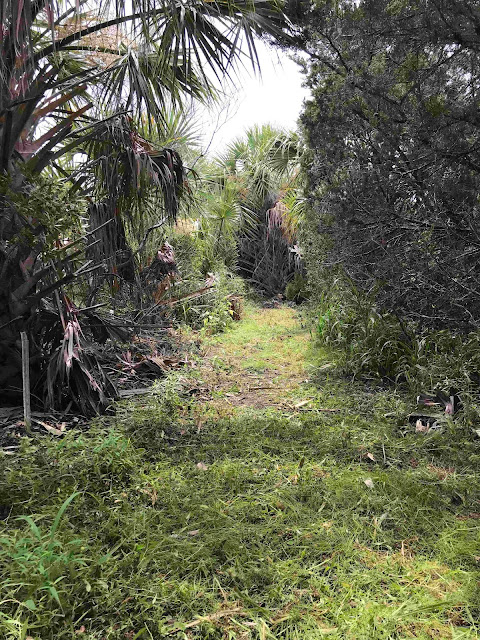Banding at Little Bear started in 2015. That first year we only started out with 10 nets but added several more net as the season progressed. Because year one was experimental, there were some major changes in 2016. We learned that we had spread some of the nets out too much and it was taking too long check them. So in 2016, we made the footprint of the banding area smaller and more manageable. Since 2016, most of the nets have been in the same place. Last year we added 3 additional nets. These nets were added in areas that were less exposed to wind and sun. Because most of Little Bear's nets are in the open, the goal was to have some nets that could be run if the others had to be shut down due to heat or wind.
Compared to Captain Sam's, Little Bear is much more open. There are very few mature trees which makes the average height of the vegetation much lower. Little Bear is much more prone to flooding as well. During rain events the swales between the dunes can hold water for a long time. During the 1000-year flood in 2015, Little Bear had a couple of feet of water standing in the many of the nets lanes. The following year, the tidal surge from Hurricane Matthew breeched the dune back by net 19 and flood the banding site with saltwater. This resulted in the killing of many wax myrtles and other shrubs. Effects from the salt water intrusion persist today because water from extreme tides will now flood the banding area.
Today's group of nets will include nets 1, 2, 17, 20, 13. These nets occur in the lower elevation area on the south side of the high dune that bisects the banding area. During extreme high tides or after significant rain fall events, all of these nets except for net 1 will be flooded.
NET 1
Net 1 is an original net that was created in 2015 and is located on high ground. Originally this net was in dense cover but after 2016, it had experienced some effects of the salt water intrusion and many wax myrtles near it died. Net 1 has captured 1,321 birds (1,110 new, 211 recaptures). This is one of the most productive nets at Little Bear.
NET 2
Net 2 is another original net from 2015. This net is located in a grassy area between two patches of scrub. This is another very good net and has captured 1,153 birds (955 new, 198 recaptures). In 2016, this net captured South Carolina's first and only Yellow-green Vireo!
 |
| Net 2 |
NET 17
Net 17 was installed in 2016. This net is located in a similar type of habitat as net 2. Originally this net had a large cedar tree on the north side of the lane but was knocked over during a hurricane a few years back creating an open grassy and weedy area in its place. Net 17 has captured 751 birds (654 new, 97 recaptures).
 |
| Net 17 |
NET 20
Net 20 began its service in 2016. This net is located parallel to the open grassy area but is tucked into the denser vegetation on the edge. This net is mostly shaded due to the many cedars and cabbage palms that surround it. This is one of the least productive nets with only 699 birds (555 new, 144 recaptures) captured in it. What it lacks in quantity, it has made up for in quality by capturing a Loggerhead Shrike in 2019 and an Ash-throated Flycatcher in 2020.
Net 13 has seen some major changes in its surrounding vegetation since it was installed in 2016. Originally this net was surrounded by large baccharis and marsh elder shrubs. But most of those shrubs have now been killed presumably by salt water intrusion. This net now runs through an open grassland with some shrubs nearby. Despite the lack of cover, this net does surprisingly well with 940 birds captured (806 new, 134 recaptures). Last year, this net captured the "best" bird of the season - a Black-whiskered Vireo in late August.
 |
| Net 13 |
-Aaron




No comments:
Post a Comment